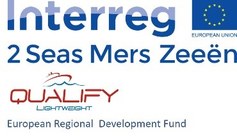Interreg 2 Zeeën - QUALIFY
Interreg 2 Zeeën

Description
The approach proposed requires a combination of capabilities and experiences not available within the national borders of individual participants. A blend of expertise is needed, which our consortium brings together. The consortium consists of following partners:
- Technische Universiteit Delft
- Cambridge University
- DAMEN SCHELDE NAVAL SHIPBUILDING
- Bureau Veritas Marine & Offshore SAS
- Universiteit Gent
- Com&Sens
- Parkwind
- Lloyd’s Register EMEA
- Stichting Kenniscentrum Windturbine Materialen en Constructies
- BAE Systems Naval Ships
A large number of observer parties is following up on the progress of the project.
The following outputs will be delivered by the project:
- Tests to assess the sensitivity to the environment of the adhesive material properties and the structural performance of the joint – at different scales
- Tailored equipment to evaluate the performance of the hybrid joint under combined loading and environmental conditions
- Accelerated tests type 1 = Rapid determination of basic fatigue properties for design purposes – at different scales
- Accelerated tests type 2 = Testing of corrosion assisted fatigue to evaluate components in a representative environment and at different scales
- Monitoring and inspection protocol
- Structural health and condition monitoring tests
- Guidelines for the qualification of adhesively bonded hybrid structures in primary structures for marine applications
Objectives
The project aims to remove the technological and regulatory barriers that currently prevent the widespread application of hybrid structures (metal/composite) in the industry. It will deliver the knowledge and the guidelines that the industry needs to pursue certification of adhesively bonded hybrid joints for primary structures in marine applications. The objectives we set to tackle this aim are:
- Objective 1: Evaluate the long term structural performance of the adhesively bonded hybrid joint under representative operational and environmental conditions;
- Objective 2: Develop a reliable inspection and maintenance methodology for adhesively bonded hybrid joints;
- Objective 3: Develop a procedure (Guidelines) for the qualification of adhesively bonded hybrid joints in primary structures in marine applications.
Role of Ghent University
Laboratory Soete of Ghent University is in charge of developing new accelerated fatigue testing equipment and procedures for the steel-composite joints also accounting for the corrosive environments. Availability of the accelerated methods are needed to reflect the lifetime of the bonded structure under realistic operation.
Website
https://www.m2i.nl/portfolio-items/qualify/
Contact
Prof. Wim De Waele
Department of Electrical Energy, Metals, Mechanical Constructions and Systems
Phone number: 09 331 04 83
E-mail: wim.dewaele@ugent.be
